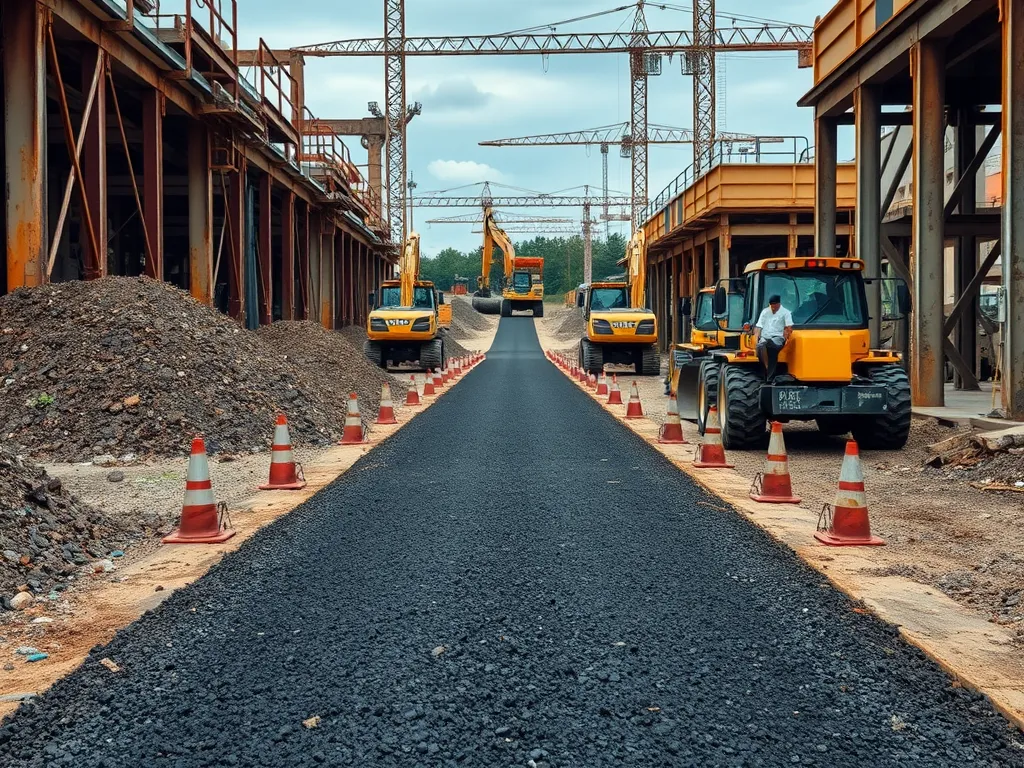Benefits Of Using Reclaimed Asphalt: Save Money and Protect the Planet
Published on: August 25, 2025 | Last Updated: April 14, 2025
Written By: George Voss
Reclaimed asphalt, made from recycled road materials like aggregates and bitumen, offers environmental benefits, cost savings, and durable performance comparable to new asphalt. Produced by milling old roads, crushing the material, and mixing it with fresh binders, reclaimed asphalt pavement (RAP) reduces landfill waste, lowers CO2 emissions by up to 30%, and cuts project costs by 20-40%. Unlike virgin asphalt, RAP reuses existing resources without sacrificing strength or weather resistance.
This article explains how reclaimed asphalt works in construction. We’ll break down its cost-saving potential, compare its durability to virgin materials, and explore recycling methods like cold processing and hot mix integration. You’ll also learn about sustainability impacts, common challenges, and answers to top questions from contractors.
Contents
What is Reclaimed Asphalt?
Reclaimed asphalt (RAP) transforms old pavement into reusable material for new projects. Contractors save money, cut waste, and maintain road quality with this recycled resource.
Definition Of Reclaimed Asphalt Pavement (RAP)
Reclaimed Asphalt Pavement (RAP) refers to reprocessed asphalt containing aggregates (crushed stone, sand) and bitumen binder. PG binders—performance-graded materials designed for specific climates—retain flexibility even after recycling. Modern RAP mixes meet AASHTO M323 standards, ensuring compatibility with virgin asphalt.
How Reclaimed Asphalt is Produced
Production starts with milling old pavements using grinders that remove 1-3 inch layers. Crushing and screening follow to achieve uniform ½-inch or smaller fragments. Hot in-place recycling heats surfaces to 300-350°F, softening existing binders for seamless integration. Cold planning keeps temperatures below 140°F, preserving 90-95% of original aggregates.
Primary Sources Of Recycled Asphalt
Key sources include:
- Road resurfacing projects: Highway milling yields high-quality RAP due to strict DOT specifications
- Parking lot demolition: Commercial sites provide 15-30 tons of recyclable asphalt per 1,000 sq ft
- Airport runways: Heavy-duty pavements offer premium aggregates for reuse
These sources reduce reliance on quarries while supplying 100 million tons of RAP annually in the U.S.
With RAP basics covered, let’s explore how these recycled materials deliver cost and performance advantages in modern construction.
Key Benefits Of Reclaimed Asphalt
Reclaimed asphalt pavement (RAP) transforms old roads into high-value materials. Its adoption grows as builders prioritize both fiscal and functional gains.
Cost-effectiveness in Construction
RAP slashes budgets without cutting corners. With 30-50% RAP integration in mixes, projects trim costs while maintaining structural integrity.
Reduced Material Expenses
Virgin asphalt costs $70-$100/ton. RAP cuts this by 20-35% by reusing existing aggregates and bitumen. Projects using 40% RAP save $15,000-$25,000 per 500-ton batch.
Lower Transportation Costs
Local RAP sourcing shrinks haul distances. For a Phoenix highway project, using stockpiled millings within 10 miles saved $8.50/ton in freight—$42,500 total for 5,000 tons.
Durability and Performance
Modern RAP processing yields pavements rivaling virgin mixes. PG 64-22 binders in recycled asphalt handle temperatures from -22°F to 130°F.
Comparable Strength to Virgin Asphalt
Lab tests show RAP mixes achieve:
- 3,500-4,200 psi Marshall Stability (vs 3,800-4,500 for virgin)
- 12-18% air voids matching Superpave standards
Resistance to Weathering
RAP’s aged bitumen resists oxidation. A Michigan study found 15% less cracking in RAP pavements after 7 winters. Polymer-modified RAP mixes boost raveling resistance by 40%.
Reduced Demand for New Aggregates
Each ton of RAP preserves 1.3 tons of virgin stone. With 100 million tons recycled annually in the US, quarrying drops by 130 million tons—enough to build 65,000 lane-miles of road.
These fiscal and functional gains make RAP a smart choice for modern paving. Now let’s unpack how to apply it through cold recycling, hot mix methods, and quantity calculations.

Implementation Methods for Reclaimed Asphalt
Reclaimed asphalt (RAP) works in many road jobs. The right method depends on project needs, budget, and site plans. Each step uses old asphalt to cut waste and boost gains.
Cold Recycling Processes
Cold recycling uses old asphalt without heat. It is done on-site or at a plant. Machines grind the old pavement and mix it with new binders like emulsified asphalt. This mix is laid as a base layer for roads. Cold methods run below 120°F, which slashes energy use by 50% vs. hot mix. It’s ideal for fixing rural roads or parking lots fast.
Hot Mix Asphalt Integration
Hot mix plants add RAP to new asphalt. The old material is heated to 300°F, then blended with fresh binder (like PG 64-22) and aggregates. Most states allow 20-30% RAP in surface layers. Tests show this mix meets strength specs for highways. Using 30% RAP can trim costs by $8-$15 per ton. Some plants now push RAP rates to 50% with polymer-modified binders.
Calculating RAP Quantities for Projects
To find how much RAP a job needs, use this math: (Road length x width x depth) x RAP density. For a 1-mile road (12 ft wide, 3 inches thick), RAP at 145 lb/ft³ yields ~1,800 tons. Tools like the Asphalt Pavement Calculator factor in waste (5-10%) and compaction rates. Right math ensures you save up to 25% on material costs and cut CO2 by 1.2 tons per 100 tons of RAP used.
These steps show how RAP fits in real builds. Next, we break down how each choice helps the earth.
Also See: Asphalt Recycling Quality Control: Best Practices
Environmental and Sustainability Advantages
Reclaimed asphalt pavement (RAP) delivers measurable eco-friendly gains that align with global sustainability targets. Contractors and municipalities increasingly prioritize these benefits to meet green building standards while maintaining road quality.
Lower Carbon Footprint
Producing virgin asphalt releases 30 lbs of CO2 per ton. RAP slashes this by 20% by reducing the need for new bitumen and high-temperature mixing. A 50% RAP blend in hot mix asphalt cuts energy use by 15-20%, lowering greenhouse gas emissions equivalent to removing 3,500 cars from roads annually.
Conservation Of Natural Resources
Every ton of RAP preserves 0.8 tons of aggregates and 10 gallons of bitumen. With 95% recyclability, asphalt outpaces materials like concrete (30%) or plastic (9%). Annually, RAP recycling saves 60 million tons of aggregates in the U.S. alone—enough to fill 15,000 football fields 10 feet deep. This preserves quarries and reduces habitat disruption from mining.
Reduction in Construction Waste
Over 90 million tons of asphalt get recycled yearly in the U.S., diverting 98% of roadway waste from landfills. Projects using RAP can earn up to 5 LEED points for waste management. For a 10-mile resurfacing job, RAP reuse prevents 12,000 tons of debris—equal to 600 dump truck loads.
While environmental gains are clear, practical challenges require attention. Up next: balancing these benefits against technical and logistical considerations.

Potential Drawbacks to Consider
While reclaimed asphalt pavement (RAP) delivers notable benefits, successful integration requires addressing specific challenges. Proper planning mitigates risks linked to performance, consistency, or logistics.
Limitations in High-stress Applications
RAP performs best in low-to-moderate traffic zones like residential roads or parking lots. In high-stress environments—busy highways, ports, or industrial sites—virgin mixes often prove more reliable. Aged binders in recycled material may lack the stiffness needed for extreme loads. Many states cap RAP content at 20-30% in surface layers of heavy-use roads to maintain structural integrity. Performance-grade (PG) binder testing ensures recycled mixes meet local climate demands.
Variability in Material Quality
RAP composition fluctuates based on source materials, milling depth, or prior pavement conditions. Inconsistent gradation, binder content, or contamination (e.g., dirt, debris) complicates mix designs. Labs routinely test stockpiles for:
| Test Parameter | Standard Method | Typical Range |
|---|---|---|
| Binder Content | ASTM D2172 | 4.5–6.5% |
| Gradation | ASTM C136 | ±2% sieve tolerance |
| Moisture | ASTM D1461 | <3% |
Processing equipment like crushers or screens standardizes particle size, but project budgets must account for pre-treatment costs.
Storage and Handling Requirements
Stockpiled RAP degrades if exposed to moisture or temperature shifts. Covered storage spaces or lined pads prevent contamination. Segregation occurs when finer particles settle at pile bases—front-end loaders rotate stockpiles to maintain uniformity. Contractors report spending $8–$15 per ton on proper storage solutions, but these investments prevent waste or failed mixes.
Optimizing RAP’s role in sustainable paving demands balancing its strengths with these practical considerations. Up next: clarifying common queries about recycled pavement performance.
Frequently Asked Questions (FAQs)
Is Recycled Asphalt Any Good?
Yes, recycled asphalt is a high-quality material that meets or even exceeds the performance standards of virgin asphalt when processed properly. It can provide similar durability and strength, making it a viable option for various paving projects.
What Are the Disadvantages Of Reclaimed Asphalt Pavement?
While there are many benefits to using reclaimed asphalt pavement (RAP), some disadvantages include variability in material quality, limitations in specific high-stress applications, and the need for proper handling and storage to maintain its effectiveness.
What Are the Negatives Of Asphalt Millings?
Asphalt millings may pose challenges such as variability in quality, potential contaminations, and the necessity for adequate storage solutions to prevent deterioration. Additionally, they may not be suitable for high-load applications without proper engineering considerations.
Is Recycled Asphalt Better Than Gravel?
Recycled asphalt is often considered superior to gravel due to its enhanced durability, ability to reduce dust, and resistance to water erosion. Moreover, it provides a stable surface suitable for high-traffic areas, unlike loose gravel which can shift and degrade over time.
How is Asphalt Recycling Conducted?
Asphalt recycling involves milling old asphalt pavements, crushing it, and screening it to create uniform material. This recycled asphalt can then be mixed with new binders and aggregates to produce reclaimed asphalt pavement (RAP) for reuse in new projects.
What is the Lifespan Of Reclaimed Asphalt Pavement?
The lifespan of reclaimed asphalt pavement typically ranges from 10 to 20 years, depending on factors such as the quality of the original materials, the percentage of RAP used, and environmental conditions. Proper application and maintenance can extend its life significantly.
How Does Using Reclaimed Asphalt Affect Project Timelines?
Using reclaimed asphalt can potentially shorten project timelines as it reduces the need for sourcing new materials, which may involve long lead times. However, proper planning and testing are essential to ensure the material’s quality and suitability for the project.
Are There Any Projects Where Reclaimed Asphalt Should Not Be Used?
Yes, reclaimed asphalt is generally not recommended for high-stress applications such as major highways or areas with heavy industrial traffic where additional performance characteristics are required. In these cases, virgin asphalt may be preferable for enhanced durability.

Closing Thoughts
The benefits of using reclaimed asphalt are clear. It offers significant cost savings, durability comparable to virgin asphalt, and environmental advantages that align with sustainable practices. Utilizing reclaimed asphalt not only conserves resources but also reduces carbon emissions, making it a responsible choice for modern construction projects.
As the industry continues to prioritize sustainability, reclaiming asphalt represents a smart solution for contractors. Reducing waste and cutting costs are not just trendy; they’re smart business strategies. By considering reclaimed asphalt for your next project, you’re investing in a more efficient, eco-friendly future.
For more information on asphalt and tools to optimize your projects, don’t forget to check out Asphalt Calculator USA.
Additional Resources for You:
- Kett, I. (1999). Asphalt Materials and Mix Design Manual. Oxford: Elsevier Science.
- Reclaimed Asphalt Pavement – Material Description – User Guidelines for Waste and Byproduct Materials in Pavement Construction – FHWA-RD-97-148
- The Benefits of Reclaimed Asphalt Pavement – L & L Asphalt Paving
- Benefits of Recycled Asphalt | Asphalt Recycling Equipment | Kemper
- Asphalt Pavement Recycling with Reclaimed Asphalt Pavement (RAP) – Recycling – Sustainability – Pavements – Federal Highway Administration


